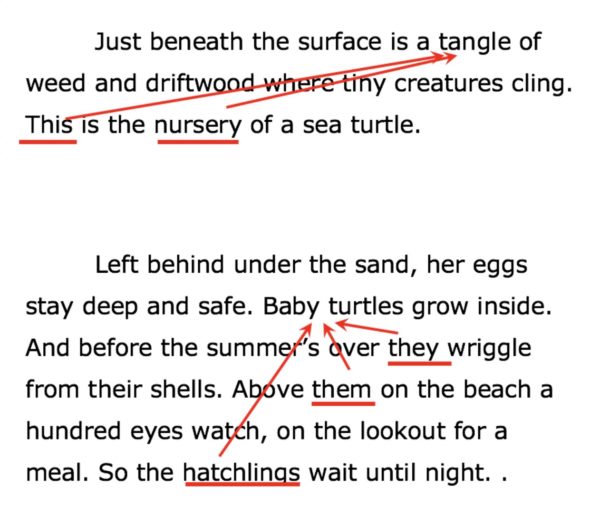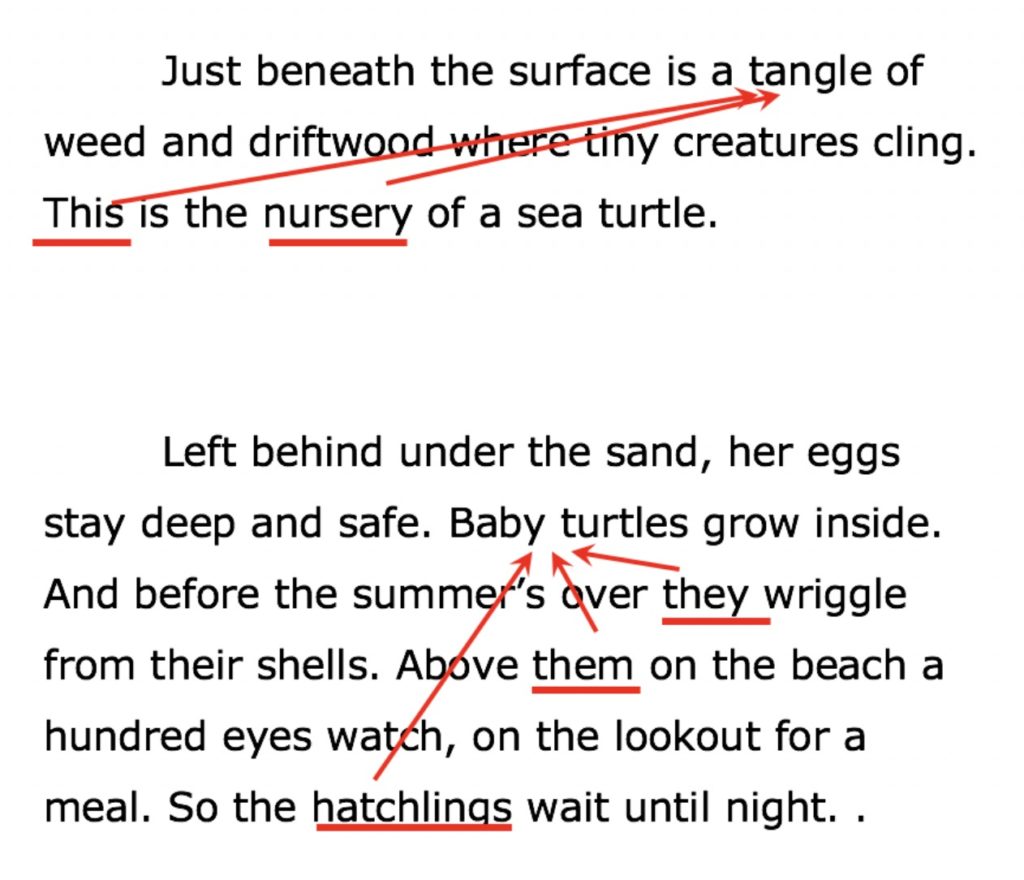What are Cohesive Devices and how do they affect comprehension?

I was recently developing some PowerPoints and activities for a comprehension training session about the role that text structure plays in reading comprehension. One of the related topics that is unfamiliar to many teachers was Cohesive Devices (sometimes called Cohesive Ties, and also known as anaphors). I thought I’d devote this post to explaining cohesive ties and how they might affect reading comprehension, especially for younger students or English language learners.
Cohesive devices are words or phrases used to connect ideas between different parts of text. There are three main types of cohesive devices:
- Pronouns that refer back to a previously mentioned noun.
- Example: Jim went out to the playground. He played on the swings.
- Substitution of a synonym for a previously mentioned noun.
- Example: There was a lot of food, but she only ate the bread.
- Transition words and inter-clausal connectors such as so or because
- Example: Jim played on the swings. Later, Jim played ball.
- Example: Mary was late, so she took the bus. Mary was late because she took the bus.
Cohesive devices affect comprehension because they help readers integrate information between sentences in a text. The pronoun, synonym, or transition word is tied to a previous word, phrase or clause (the antecedent). Many students, even skilled readers, never consciously think about authors’ use of cohesive devices. It is helpful for teachers to draw attention to this kind of text structure, especially for students who have difficulty comprehending a series of sentences that include cohesive ties. Children with poor reading comprehension make more errors on questions that can only be answered if a pronoun has been correctly resolved. They are less likely to supply the appropriate anaphor in a cloze task. For example, “Steve gave his umbrella to Andrea in the park because ___ wanted to keep dry.” (Carlisle & Rice, 2002; Cain & Oakhill, 2007) Also, poor comprehenders’ difficulties are particularly pronounced when there is intervening text between the anaphor and it’s antecedent.
Examples
Look at the two examples below. The cohesive ties are linked to their antecedents with arrows. Notice how there can be multiple cohesive ties within a single paragraph!

Instructional Suggestions
As a means of drawing students’ attention to cohesion, have them identify all the words that “stand for” other words, phrases, or a clause in a short, familiar passage from material students are reading. For young children, many of the read aloud texts that teachers use to develop vocabulary and comprehension include examples where the author has used pronouns, synonyms, and transitions to connect sentences. For good readers, an activity such as this may be all that is necessary to encourage greater attention to the connections between sentences. The following are some recommendations for students who have difficulty understanding cohesion (Maria, 1990):
- Have students match the cohesive tie with its antecedent. There are several ways to do this. Students may draw arrows from the cohesive ties to the words they replace, write the antecedent above the cohesive tie, or write the same number over words that are linked. Some students may benefit from applying one of these techniques as they read.
- Have children read a passage and answer questions that require comprehension of cohesive ties.
- Delete pronouns from a passage, and have students fill in the blanks.
- Give students a passage in which names and other sentence components have been unnecessarily repeated. Ask them to substitute cohesive ties for the repetitious information.
- At times, the antecedent of a pronoun may be somewhat ambiguous. Some children may need to be taught how to use “clues” such as number and gender to figure out what pronouns stand for.
- Example: Joe and Laura went to the beach. He played in the water while she looked for shells. Afterwards, they had a picnic lunch.
In other instances, children may need to draw on background knowledge and reasoning skills to determine the most probable antecedent of a pronoun. In the following example, it more likely refers to the mall than to the bank since John was able to conduct his business at the bank: John went to the mall after he deposited some money in his account at the bank. It was closed.
References:
Cain, K. & Oakhill, J. (2007). Reading comprehension difficulties: Correlates, causes, and consequences. In K. Cain & J. Oakhill (Eds.) Children’s comprehension problems in oral and written language. New York: Guilford Press. pp. 48-49
Carlisle, J.F. & Rice, M. S. (2002). Improving reading comprehension: Research-based principles and practices. Baltimore, MD: York Press. pp. 129-130

 Joan Sedita is the founder of Keys to Literacy and author of the Keys to Literacy professional development programs. She is an experienced educator, nationally recognized speaker and teacher trainer. She has worked for over 35 years in the literacy education field and has presented to thousands of teachers and related professionals at schools, colleges, clinics, and professional conferences.
Joan Sedita is the founder of Keys to Literacy and author of the Keys to Literacy professional development programs. She is an experienced educator, nationally recognized speaker and teacher trainer. She has worked for over 35 years in the literacy education field and has presented to thousands of teachers and related professionals at schools, colleges, clinics, and professional conferences.
Thank you for the detailed information.
Thanks for sharing a comprehensive guide on comprehension. This will help English language learner to know about the connectors. I enjoyed reading this article.
Thanks for sharing such knowledge
thanks to use such a simple method.
Thanks for sharing this knowledge.
Thank you for this article. Having gone to school in the early 60’s, we learned this from a textbook. The teacher didn’t have to find articles like yours to realize that this very important concept is forgotten! We need English Language textbooks back, even /especially for grade school.
This was very helpful, thank you.
Your explanation is clear and informative. Thanks.
So simplified discourse with a lot of things to learn. Thank you
Hello, when I think of skills in Scarborough’s Rope would this go under the sub category of language structures because it involves syntax and semantics?
Yes, it is part of the language comprehension part of the reading rope.
Is there a book, lesson plans, or curriculum for teachers to present this to students? Thank you!
Chapter 8 in Nancy Hennessy’s book “Reading Comprehension Blueprint” includes suggestions for teaching cohesion.
Thank you! I was having difficulty clarifying my goal and this piece helped me write it in more detail.
Thank you very much this was very helpful
Very very helpful.
Thanks for the post.
What a great, compressed explanation. The color coding at the paragraph level of instruction makes it practioner-friendly. Sorely needed for many of our students on the spectrum. Thank you!
Your insights are always spot-on. Keep up the great work!